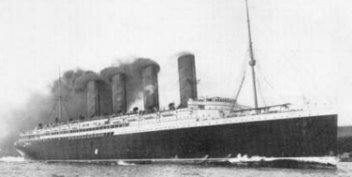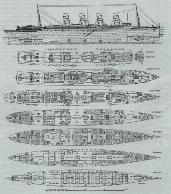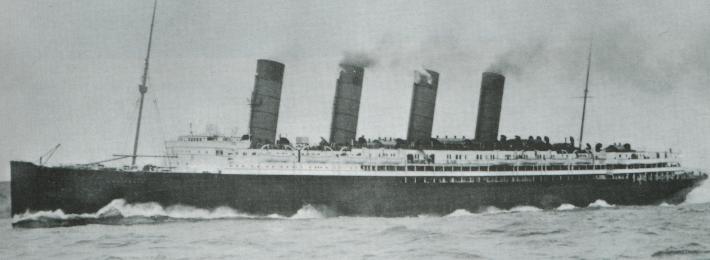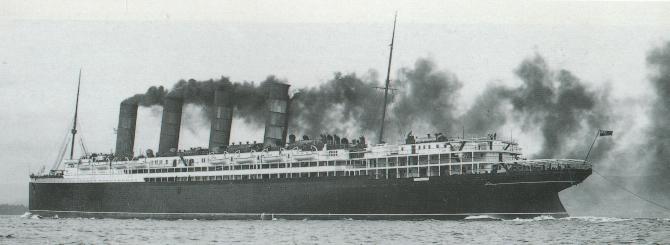Harland & Wolff
Ships
|
Cunard Ships: |
|
other Ships |
The RMS Lusitania
THE BEGINNING The race was on to gain dominance of the Atlantic crossing. The Late 1890s saw four new ships from Germany that threatened to put an end to the British dominance of the Atlantic. The ships produced by Germany were fast and luxurious. Britain tried to retaliate by planning the commission of two ships in 1902. The ships would have to be the largest, fastest and most luxurious than ever built before. The Cunard Line decided (after serious negotiations) to let John Brown & Co. of Clydebank, Scotland build the Lusitania and Swan Hunter & Wigham Richardson on the River Tyne to build the Mauretania. Before construction could begin there was a small problem of finance. £2,600,000 would be needed to build the ships. Negotiations started between the Cunard Line and the British Government. The Cunard Line wanted to secure a loan repayable over 20 years at low interest. The British Government agreed to grant the loan on the basis that the ships would be built to Admiralty specifications and that the ships could be called into active military service whenever the need arose. This would mean that the ships would have to be fast especially in active service because neither ship could be a sitting duck for enemy gunfire. In fact in the Spring of 1909 her three bladed propellers were replaced with four bladed ones to give her extra speed. Bearing this in mind, Lord Inverclyde discussed the Cunard Agreement with a committee of experienced engineers in the September of 1903 to calculate what was needed to fulfil the contract. Leonard Paskett produced the early designs for the two ships. Careful consideration was given to the layout of the ship. Most of the machinery was installed beneath the waterline. Her original plans gave the ships three funnels but the final plans gave them four.
CONSTRUCTION Her construction was divided into two sections: Front and stern. Her forward end was almost completed before the stern had started. This allowed the designers extra time to arrange machinery in the engine rooms. By the end of Spring 1905, the Lusitania's double bottom was in place. The work continued, paying particular attention to the stern of the ship. As a Naval Rescue Ship she would have to be quick as well as elegant. The Lusitania was launched by Lady Inverclyde on the 7th June 1906 at 12.30 p.m. The occasion was marked with 600 VIP guests. The ship took only 86 seconds to launch. Work had taken 17 months so far. Her hull weighed 16,000 tons but once she was fitted with her boilers, engines, panelling etc, she would weigh 41,000 tons. Once completed Britain would have the grandest ships afloat. There was hope to regain the Blue Ribband. It took just under one year to fit the ship out. Hundreds of workers worked around the clock trying to keep up with the strict deadlines placed on them by the British Admiralty. Once completed the Lusitania left the Clyde to commence her sea trials. No record has survived relating to what turned up during the trials but many alterations were made following the conclusion of the trials. Most of them were made to the stern section. INSIDE THE SHIP Like the Titanic to come, the Lusitania looked to many different historical ages and styles to decorate the different compartments and staterooms etc. Her first class lounge and Music room on the boat deck was completed in Georgian style with a yellow and green colour scheme top complement the mahogany panelling. There was a stain glass skylight overlooking the room. It was a delightful setting. A fireplace sat across the length of the room. Each room was fitted with magnificent enamels. The plaster work was surpassed. As can be imagined, the first class dinning room resembled kings' palace ballroom. It echoed the splendour of the French King Louis Seize. There was a dome at the top of the balcony. The dome contained segments depicting the four seasons re-enacted by Cherubim. The sleeping quarters were also of fine fitting. The Lusitania had six standard size suites that had three rooms within each suite. She also had two "Regal Suites" which had two bedrooms, a sitting room, dinning room, private bath, lavatory and pantry. Again different periodic styles were used to decorate the rooms. Most rooms were French based design resembling some of the rooms in the Palace of Versailles. This gave the impression that all the rooms were different and individual. If you were a passenger, you were not actually on a ship, but staying in a very exclusive grand hotel. The ensuite crooms were situated on the Promenade Deck. Each had their own bath and toilet. They were not as large as the Regal Suites but a first class passenger could not even consider complaining. Like the Titanic, the Lusitania followed the tradition of having a smoking room for the gentlemen to use after dinner to be parted from their respective partners to discuss the meaning of life. The rooms had an Italian 18th Century style. There was a stained glass barrel vaulted dome. There were two fires in the room actually burned coal. There were eight fires on the ship in total but six of them were electric. There were many little luxurious aspects to her design. A first class elevator, double door to keep the heat in, reading rooms and of course the Verandah Café located on the boat deck. As a point of interest, the designers originally wanted a gymnasium instead of the verandah café but this did not happen. The second class rooms were not as luxurious as the first class ones but were still remarkable. The second class dining room was one of the grandest rooms afloat of its day. Huge pillars had been placed in the dining room to add stability to the rooms. The policy of the Cunard Line was to pride both the first and second class passengers with rooms not dissimilar to those they would find in the hotel rooms they would frequent. The different styles used throughout the ship certainly achieved this. A smoking room was also included for the second class gentlemen. They enjoyed sitting under a barrel vaulted stained glass skyline. The drawing room on the Promenade deck was furnished in the style of Louis Seize of France. The different shades of grey and rose complimented the satinwood furniture. The second class accommodation was fine as well. Their cabins were very spacious. Some were bigger than those of the first class were. The third class cabins and rooms were almost standard compared to the first and second class. However, when they are compared to other transatlantic ships of the day, they would be seen to be very luxurious indeed - almost first class. Most of their sleeping quarters were designed to hold between two and eight people. Life onboard would have been very different but the third class knew this and perhaps just accepted it. LIFEBOAT CAPACITY As per the Regulations of her day, the Lusitania carried 16 wooden lifeboats. By 1910 society had placed the building of liners so superior that they had become practically unsinkable. Basically the same reason why the Titanic only carried the number of boats it did. However, following the loss of the Titanic, the Lusitania was fitted with 48 boats (22 wooden and 26 collapsible). Every boat was fitted with 2 chains to anchor them to the deck. This would prove disastrous when the ship sank because the chains would have to be released before the boats could be swung clear of the ship. When the Lusitania was sinking many of the chains were not released and thus preventing the boats from being launched successfully. Many boats went down with the ship. MAIDEN VOYAGE On the 7th September 1907 under the command of Captain James B. Watt, the RMS Lusitania sailed on her maiden voyage to New York. She carried over 3,000 passengers and crew. Her passengers were delighted with the new ship. The standards of accommodation and services were well documented. Most third class passengers enjoyed the voyage. Dinning on her was like eating in the best restaurants or hotel anywhere.
She arrived in New York on the 13th September 1907. Her voyage lasted 5 days and 54 minutes. She did not recapture the Blue Ribband on this occasion, which was a great disappointment of the authorities and owners. Her second voyage was quicker. She averaged 23.993 knots crossing the Atlantic in less than 5 days. She recaptured the Blue Ribband. The British held the record for the next 22 years until the German liner Bremen earned it in 1929. |



